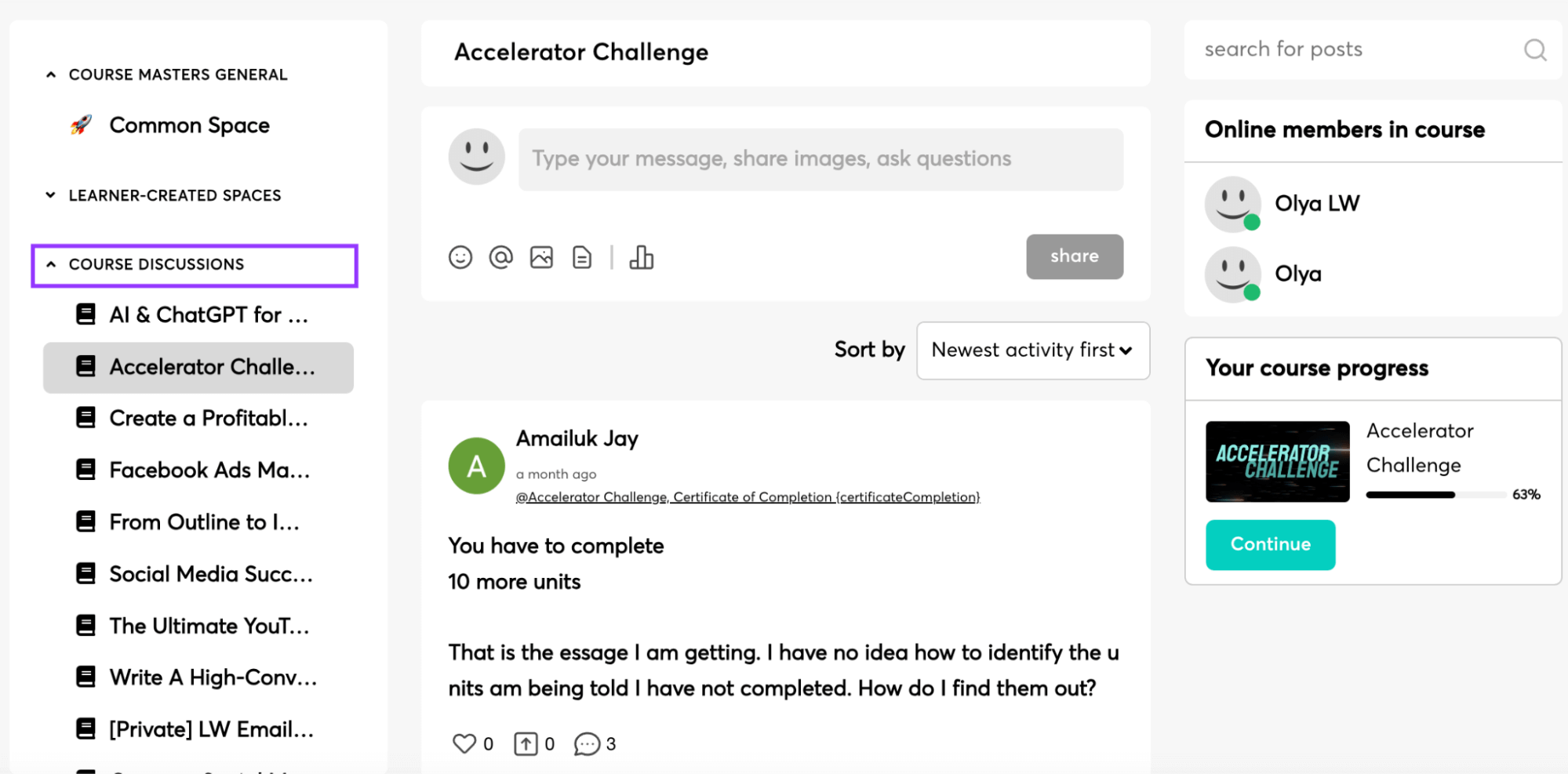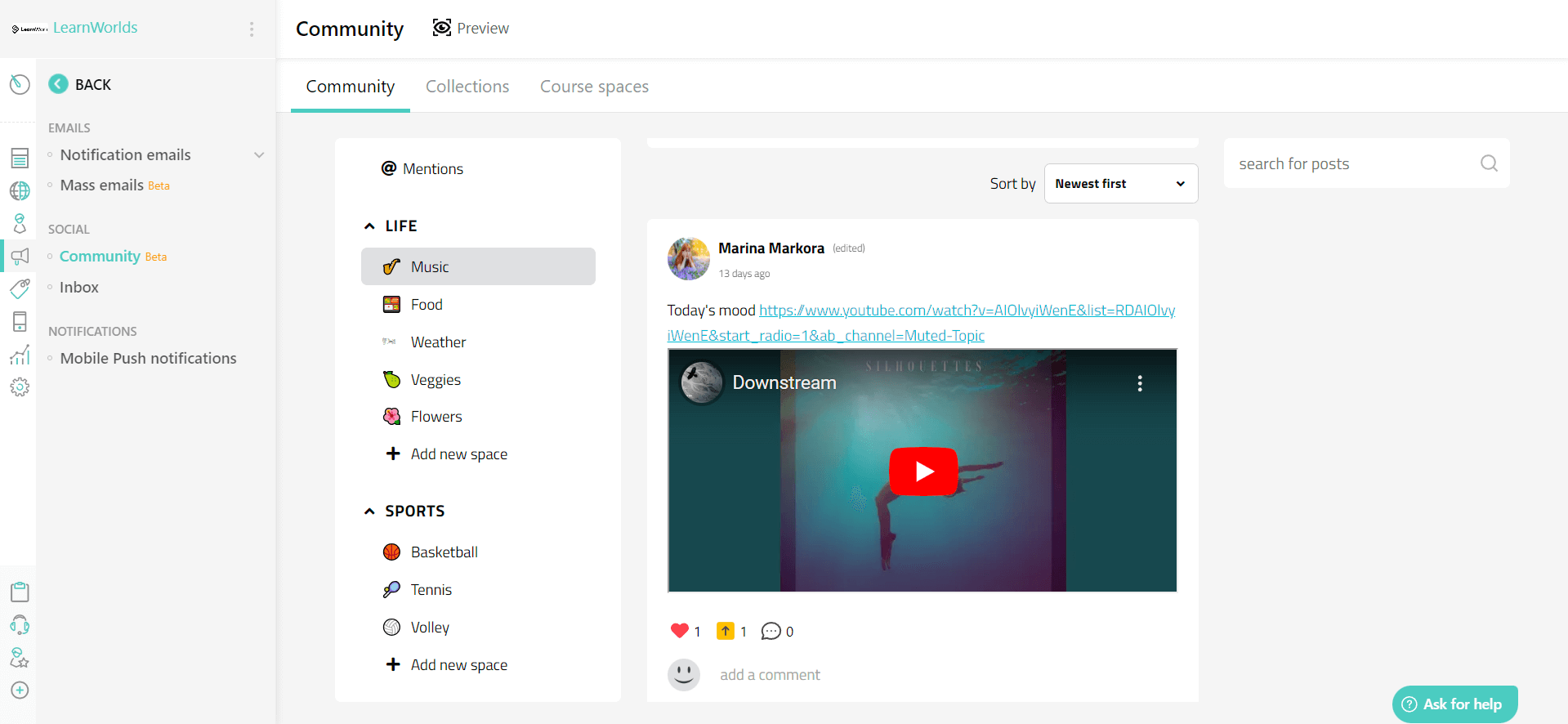Table of Contents
Ever felt like online learning could use a bit more… magic? Well, this is where community management swoops in as the game-changer. It’s not just about courses and textbooks anymore-it’s about creating spaces where people can learn, connect, and be inspired.
According to a recent study from the University of Central Florida, students with access to peer support are 23% more likely to up their academic game. That’s a solid win for teamwork and collaboration!
But it’s not just students. Companies that build strong learning communities, as found by Salesforce in 2021, are 3.5 times more likely to nail their business goals. Learning isn’t just for school; it’s a big player in the professional game too.
Your professional looking Academy in a few clicks
Start FREE TrialDeloitte even jumped into the mix in 2020, showing that employees hanging out in online learning communities are more likely to stick around with their companies. Job satisfaction alert!
The latest study from IBM showed that online learning communities can boost employee productivity by a whopping 20%. Imagine what a supportive digital space can do for your work mojo!
So, as we kick off this journey into effective community management, let’s keep these stats in mind. We’re not just talking numbers; we’re uncovering the real-life impact of building awesome online communities.
Get ready for some practical tips and tricks that can turn your learning space into something truly special.
Best Practices for Effective Community Management
Building successful online communities, whether in B2B or B2C environments, involves understanding the unique needs and dynamics of your audience and consistently adapting your approach based on their feedback and engagement levels.
In this section, we’ll unravel a set of best practices, each a crucial element in the art of effective community management.
From defining your community’s essence to choosing the perfect platform, nurturing a team of dedicated moderators, and fostering a sense of belonging, these practices lay the foundation for a vibrant and purpose-driven digital forum.
As we delve into each practice, consider them as the keys to unleashing the full potential of your virtual community, ensuring that it becomes a social network where members not only learn but actively contribute, connect, and find value in being part of a collective journey.
So, think of effective community management like crafting a really great playlist—each element adds to the overall vibe, making it a space where a group of people connect, answer questions, share common interests, empower each other, and find success together.
Now, let’s explore these practices that make your community a hit!
1. Setting the Heartbeat 💖 Define Your Community’s Essence and Values
Before you start with your community building, it’s important to have a clear understanding of what you want to achieve.
Answer the following questions:
Once you have a clear purpose and values, you can start to attract the right kind of like-minded people and build a strong community culture.
🏢B2B Best Practice Example
Imagine you’re a B2B course seller specializing in professional development. Your community’s purpose could be to create a social community where industry experts, learners, and professionals come together to share insights, discuss emerging trends, and foster a culture of continuous learning.
Your values revolve around knowledge exchange, respect, and collaboration.
By defining this purpose and these values, you attract individuals who align with your vision, creating an internet community that not only acts as a brand community and promotes your online courses but also establishes you as a thought leader in your industry.
🛍️B2C Best Practice Example
In a B2C context, imagine you are a nutrition coach offering online courses in healthy living. Your community’s purpose is to be a haven for new members with shared interests committed to fostering a nutritious lifestyle.
The values that guide this community include encouragement, transparency, and a passion for holistic well-being.
By setting this clear purpose and these values upfront, your new community becomes a magnet for health enthusiasts who resonate with your vision. It’s not just an online space to learn about nutrition; it’s a digital home for those who believe in the transformative power of healthy living.
This clarity not only attracts the right members but also lays the foundation for a robust community culture where members share recipes, fitness tips, and support each other on their wellness journeys.
2. Setting the Stage 🌟 Craft the Perfect Haven for Your Community
There are many different types of online community platforms available for hosting your online communities. The best space for you will depend on the size and nature of your community, as well as your budget and technical expertise.
In the context of social media platforms, you can choose one of the most popular online community platforms like Slack, Discourse, LinkedIn Groups, and Facebook Groups. However, if you are looking for a space where you can have supreme customer community control without depending on third-party platforms, you can leverage the power of a robust learning management system, like LearnWorlds that offers a sleek and user-friendly built-in community.
🏢B2B Best Practice Example
As a B2B course seller focused on executive leadership training, choosing LearnWorlds with its integrated community feature becomes a strategic move.
LearnWorlds provides a seamless learning and community experience within the same platform, offering a dedicated space for professionals to engage in discussions, share insights, and collaborate on leadership challenges.
This integrated approach not only enhances the user experience but also aligns with the professional and educational nature of your B2B courses. Add to it the fact that you have 24/7 customer support at your fingertips so that you can focus on what matters most, working on your community engagement, not solving tech issues!
🛍️B2C Best Practice Example
For B2C course sellers in verticals like the culinary arts space, LearnWorlds’ built-in community feature becomes the perfect platform choice. Here, each course automatically generates its own dedicated private Community Space when the course discussion is enabled. This allows cooking enthusiasts to connect with fellow learners of the specific course topic, share their culinary creations, and participate in recipe discussions.
LearnWorlds’ integrated community fosters a sense of belonging and provides a safe haven for individuals passionate about honing their cooking skills in a social and educational setting.
Focus on empowering your community members to share user-generated content (e.g., recipes, tips, hacks, etc.) and you will have a vibrant community and even ideas for new products!
Your professional looking Academy in a few clicks
Start FREE Trial3. Setting the Community Guardians 🛡️ Build a Strong Moderator Team
Moderators are responsible for keeping your community safe, respectful, and on topic. They should be active members of the community who understand your values, and are committed to upholding your community guidelines.
🏢B2B Best Practice Example
In a B2B community focused on marketing strategies, your moderators could be seasoned marketers with a deep understanding of industry nuances. Their role would be to guide discussions, maintain professionalism, and ensure that the community stays on top of the latest trends and best practices.
🛍️B2C Best Practice Example
For a B2C fitness community, your moderators could be certified fitness trainers passionate about fostering a positive and encouraging environment.
These moderators could play a vital role in steering discussions toward constructive fitness goals, offering guidance, and maintaining the community’s inclusive vibe.
4. Setting The Feeling 🌱 Nurture a Sense of Belonging
People are more likely to be engaged in a community if they feel like they belong. Create opportunities for members to connect with each other, both online and offline. You can do this by organizing online events, hosting discussions, and creating a welcoming and inclusive atmosphere.
🏢B2B Best Practice Example
Imagine you’re a B2B consultant offering courses on project management. You can organize virtual roundtable events where professionals can share their project successes and challenges.
This not only encourages knowledge exchange but also creates a tight-knit community where members feel connected, valued, and part of a collective journey toward project management excellence.
🛍️B2C Best Practice Example
In a B2C context, let’s say that you are a cooking instructor running online classes. You can create a dedicated space for members to share their culinary creations inspired by your courses. You can also host online cooking parties where you can inform participants beforehand to have the ingredients of the recipe that will be presented during the event.
This way, they can cook the dish at the same time as you. This builds a sense of belonging among members who share a common love for cooking and learning from your expertise.
5. Setting the Pace 🏃♂️ Encourage Active Participation
Don’t just wait for people to come to you. Actively encourage participation by asking questions, sharing resources, and celebrating members’ achievements. You can also use gamification and other incentives to keep people engaged.
🏢B2B Best Practice Example
If you’re a B2B sales training provider, you could initiate discussions by posing real-world sales challenges and encouraging members to share their experiences and solutions. Recognize and celebrate the best strategies. Consider incorporating a leaderboard for top contributors, adding a competitive edge that motivates ongoing participation.
🛍️B2C Best Practice Example
For a B2C photography course, you could create weekly photo challenges where participants can showcase their skills. Offer constructive feedback and highlight standout submissions. Throw in some fun rewards or feature the best photos on your platform, turning the learning experience into an exciting and interactive journey.
6. Setting the Tone 👂 Listen to Your Members
Your members are the experts on what your community needs. Make sure to listen to their feedback and suggestions. This will help you to keep your community relevant and engaging.
🏢B2B Best Practice Example
In a B2B finance community, actively seek feedback on potential course topics, format preferences, and additional resources needed. Incorporate member suggestions into your course offerings, ensuring that the content stays relevant and directly addresses the challenges and interests of your professional audience.
🛍️B2C Best Practice Example
If you’re a B2C life coach offering personal development courses, conduct regular surveys to understand your community’s goals, struggles, and aspirations. Tailor your content to directly address the needs of your members, creating a more personalized and impactful learning experience.
7. Setting the Standard 🏆 Be Consistent and Reliable
Members need to know that they can count on your community to be there for them. Set clear expectations, communicate regularly, and follow through on your promises.
🏢B2B Best Practice Example
As a B2B cybersecurity training provider, establish a regular schedule for sharing industry updates, new course releases, and expert insights. Consistency fosters trust, assuring your community that they can rely on your platform for the latest information and valuable learning opportunities.
🛍️B2C Best Practice Example
For a B2C gardening instructor, consistently share seasonal gardening tips, answer queries promptly, and maintain an active presence. This reliability ensures that your community sees your platform not just as a place to learn but as a dependable resource for their gardening journey.
8. Setting the Metrics 📊 Measure Your Success
Track key metrics such as member engagement, content creation, and overall satisfaction. The more real-time you can do this, the better. This will help you to identify areas where you can improve and make sure that your community is on track to meet its goals.
🏢B2B Best Practice Example
In a B2B community focused on digital marketing, track metrics like engagement levels during live webinars, the number of successful marketing campaigns initiated by community members, and overall satisfaction with the provided resources. These metrics offer insights into the community’s impact on professional growth.
🛍️B2C Best Practice Example
If you’re a B2C coding instructor, track metrics such as the completion rates of your coding challenges, the number of personal projects initiated by community members, and overall satisfaction with your teaching style. These indicators provide valuable feedback on the success of your community in fostering retention and individual skill development.
9. Setting the Zen 🧘♂️ Be Patient
Building a successful community takes time and effort. A study by the Community Roundtable showed that it takes an average of 6 to 12 months for a community to reach a critical mass of active users.
This means that in the initial stages, growth may seem slow and incremental. However, this is not a sign of failure; it’s simply the nature of community building.
Given the reality of slow initial growth, it’s understandable that community builders may feel discouraged. However, it’s important to remember that consistency and persistence are key to building a lasting and thriving community.
🏢B2B Best Practice Example
Suppose you’re a B2B consultant offering courses on business strategy. Building a community of business professionals eager to engage in strategic discussions takes time. Don’t be disheartened if the initial response is gradual. Keep consistently delivering value, and over time, your community will grow into a thriving hub of strategic minds.
🛍️B2C Best Practice Example
In the B2C fitness world, as a personal trainer providing online classes, you have to understand that individual fitness journeys vary. Some members might take longer to actively participate or share their progress. Patience is key in allowing each member to find their comfort zone within the community and start contributing.
Navigating LearnWorlds Community Management Dashboards
All of the above best practices must be implemented along with a robust platform for creating and hosting your community.
LearnWorlds’ built-in community feature is a game-changer for your online course business. Consider it the key that not only unlocks success but also fosters a thriving and meaningful relationship with your learners.
With seamless integration of community elements into courses, you can foster dynamic student-instructor interactions through features like Course Discussions. This not only enhances engagement but also transforms your learners from passive recipients to active participants, contributing to more meaningful and collaborative learning experiences.

The Community Spaces in LearnWorlds act as dedicated chat rooms for focused discussions tied to course content. This extension beyond the in-person or virtual classroom allows learners to delve deeper into topics, promoting continuous engagement. These spaces provide a unique environment where students can connect, share insights, and seek clarification, enriching the learning journey.
LearnWorlds’ Social Learning Activities, integrated into the course modules, add a dynamic social layer to the learning journey. By strategically placing conversation starters or debate initiators, course creators spark engaging discussions among learners.

And here as well, LearnWorlds community built-in feature enables you to spark engaging discussions with your learners right from the inside your ebooks! How? Well, with the help of a “social widget” that you can add at the end of a topic covered in one of your ebooks.
This social widget enables you to seamlessly embed right inside your ebook the actual community space where a conversation about the specific topic occurs. This minimizes distractions, ensuring they remain focused on their learning without having to navigate away from the activity to engage in relevant discussions. Pretty cool, isn’t it?
This social-based learning not only enhances understanding but also promotes the exchange of diverse perspectives, creating a vibrant and interactive educational experience.
For subscription-based models, the LearnWorlds community becomes the heartbeat of the learning experience. Private Community Spaces, accessible at different subscription levels, act as exclusive clubs where networking, support, and mentorship thrive.
This sense of community fosters deeper, more personal connections among learners, improving the customer experience you offer and boosting your brand loyalty by transforming your learners into loyal advocates of your courses and programs.

In addition, LearnWorlds’ intuitive community layout, with left and right sidebars and a central feed, ensures a well-organized and user-friendly experience.
With LearnWorlds’ built-in community you can set three distinct user roles within your school community for effective community management: the Community Managers who help you organize your community structure in spaces and collections and moderate community content, the Space Managers who moderate community spaces and the Space Members, who comprise the users of your school that visit and use your community.
Besides, the LearnWorlds Community feature offers valuable insights into learner preferences and needs. By monitoring discussions and interactions, course creators can refine and enhance their courses, staying innovative and responsive to evolving market demands. This continuous improvement loop ensures that courses not only meet but exceed learner expectations.
💁Discover more about the power of LearnWorlds Built-in Community and how it can add value to your ed-business offering in this article.
Ready to amp up your learning experience? Try out LearnWorlds with a 30-day free trial! See firsthand how our community features can take your education game to the next level.
Your professional looking Academy in a few clicks
Start FREE TrialFrequently Asked Questions
What is an Online Community?
An online community is a virtual space where people with common interests, goals, or affiliations gather to interact, share information, and engage in discussions. It provides a platform for building connections and fostering a sense of belonging among its members.
What is a Branded Online Community?
A branded online community is a specialized virtual space created and managed by a specific brand or organization. It serves as a hub for their audience to connect, share experiences, and access exclusive content. The branding ensures a cohesive and unique identity aligned with the organization’s goals.
How Many Types Of Online Communities Are There?
Online communities come in various types, such as forums, social networks, and interest-based groups. They can be categorized into communities of practice, communities of interest, and communities of purpose, each catering to specific objectives and interactions.
How Online Community Platforms Differ from Facebook or LinkedIn Groups and Support Communities?
While Facebook and LinkedIn groups offer basic community features, online community platforms provide more specialized and customizable functionalities. These platforms are designed to cater specifically to community building, offering enhanced moderation tools, member engagement features, and a unique branded experience.
How To Choose The Best Online Community Platform For You?
Choosing the best online community platform involves considering factors like the specific needs of your community, customization options, scalability, and ease of use. It’s crucial to assess whether the platform aligns with your goals and offers the features necessary for fostering meaningful interactions.
What Are The Five Qualities Of Online Communities?
What Are The Key Features Of The Online Communities?
Rosemary is LearnWorlds’ Content Marketing Manager. She has over 2 decades of experience in omnichannel marketing and content writing for the IT and SaaS industry. Her expertise lies in crafting effective content marketing strategies that attract, engage, and nurture customers, enabling LearnWorlds to reach its target audiences with precision.




